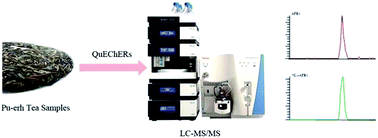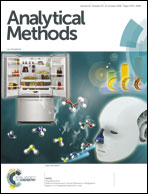Rapid qualitative and quantitative analysis of aflatoxin B1 in Pu-erh tea by liquid chromatography-isotope dilution tandem mass spectrometry coupled with the QuEChERS purification method
Abstract
The unique quality of Pu-erh tea is due to the process of pile fermentation that the tea leaves undergo, but this process can lead to the risk of producing aflatoxin B1 (AFB1), the most toxic of aflatoxins. The commonly used methods for the determination of AFB1 in foods are complex and time-consuming. In this paper, an accurate and rapid method for the determination of aflatoxin B1 in Pu-erh tea was developed by isotope dilution mass spectrometry. After extraction of AFB1 in Pu-erh tea using acidified acetonitrile (1% formic acid), a purification step was performed by the QuEChERS (Quick, Easy, Cheap, Effective, Rugged and Safe) method with primary secondary amine (PSA) and octadecylsilyl silica (C18) as the absorbents. The quantification of AFB1 was performed by liquid chromatography tandem mass spectrometry (LC-MS/MS) in positive mode (ESI+) and selective reaction monitoring (SRM) with 13C-labeled aflatoxin B1 (13C17-AFB1) as the internal standard in less than 5 min. A complete validation study was carried out after method optimization to ensure adequate performance of the developed method. The results showed good linear correlation in the range from 0.10 to 10.00 μg L−1 with a correlation coefficient (R2) > 0.99. The average recoveries of AFB1 from blank samples fortified at three levels (0.50, 5.00, and 20.00 μg kg−1) ranged from 81.4 to 100.8% with the relative standard deviations (RSDs, n = 6) between 1.7 and 4.8%. The limit of detection (LOD) was 0.50 μg kg−1. The validation method was applied to an analysis of AFB1 in 50 raw Pu-erh teas and 50 ripened teas. None of the investigated Pu-erh samples showed an AFB1 content above the LOD. The results indicate that people who are keen on drinking Pu-erh tea are not at risk from AFB1 exposure. The proposed method was demonstrably simple, rapid, highly sensitive and accurate, and was effective in the rapid qualitative and quantitative analysis of AFB1 in Pu-erh tea.



 Please wait while we load your content...
Please wait while we load your content...